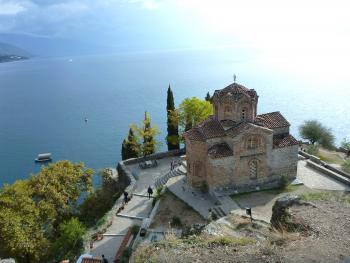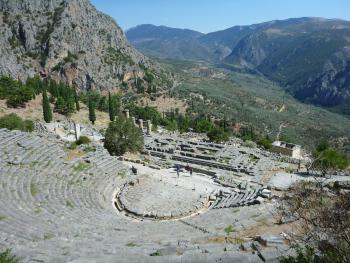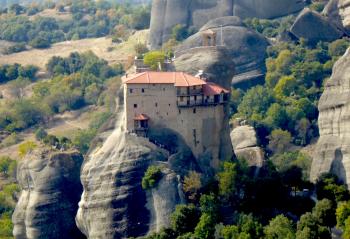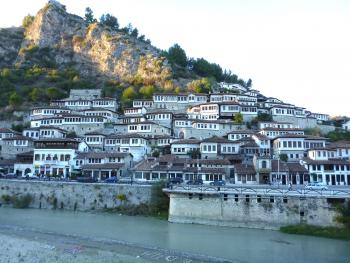Exploring the sites of northern Greece and the Balkans beyond
This article appears on page 20 of the April 2019 issue.
I had booked a group tour that would take my sister Gretchen and me to northern Greece, Macedonia and Kosovo in September-October 2017, but I also wanted to add on some days in Albania, so I arranged a private tour ($1,650 per person for two) with Barbara Sansone of Original World (San Rafael, CA; 888/367-6147, originalworld.com).
Then, two months before our scheduled departure, I was notified that the group tour was canceled because not enough people had signed up. I contacted Barbara Sansone again, and she was able to arrange for us to take the same itinerary that we would have taken on our previously scheduled tour for $5,500 per person. The price included airport transit, 4-star hotels with breakfasts and a driver and guide in each country. It ended up being a wonderful trip!
We saw many UNESCO World Heritage Sites and learned a lot about the southern Balkans and the role that the US has played in their history. And it was a private tour for just the two of us!
Getting acquainted with Greece
Gretchen and I began in Athens and traveled to Delphi, a UNESCO Site, where we climbed up through the ruins of this historic place where once the oracle was consulted about important decisions affecting the ancient classical world. We finished off the day with a visit to another UNESCO Site, St. Luke Monastery, followed by dinner at an olive farm overlooking the Gulf of Corinth.
Continuing north, we stopped at Thermopylae, where a famous battle had been fought between Greek city-states led by Sparta and the Persian Empire of Xerxes I. We then moved on to Meteora, a monastery complex I had wanted to visit for some time. We explored some of the 24 monasteries that were begun around the 14th century. Built on rock outcrops, they were once only accessible by removable ladders or ropes; nowadays, there are stairs carved into the rocks.
We were able to visit several of the six monasteries that still remain.
While in this area, we took an optional excursion farther west in the mountains to watch a truffle hunt ($165 per person). We had a lot of fun watching a farmer and his wife using their trained dogs to find the truffles. (We learned that they have a pig that is really good at digging for the underground mushrooms, but she is too rough to use around visitors.) After the successful hunt, they served us truffle soup, truffle casserole and a truffle omelet on a picnic in the forest.
Probably the most amazing stop of the trip was the Museum of the Royal Tombs of Aigai in Vergina.
I can just imagine how exciting it was for Manolis Andronikos to find the tomb of the father of Alexander the Great (as well as the tomb of other family members) in 1977. The museum, which encompasses the actual tombs of Philip II of Macedon and others, didn't look like much as we approached, but when we entered and walked down a distance into the green hill inside which it is situated, we found a spectacular museum. No photos were allowed inside, so we bought postcards showing the tombs and exhibits of the gold artifacts that were found there.
We then had two nights in Thessaloniki, with a tour of the city. The fortress walls high above the city, a tower from the Old City walls and a statue of Alexander the Great on his horse were just a few of the sites we visited in this interesting city.
Moving on to North Macedonia
It wasn't long before we were at the border with the country of Macedonia (now known as North Macedonia). We left the Greek province of Macedonia and entered what the Greeks call the FYROM, or Former Yugoslav Republic of Macedonia. There we met a new guide and continued on to our first stop, Ohrid.
Our weather for the scheduled boat ride on Lake Ohrid wasn't great, but there were many other sights to see.
We visited the Monastery of St. Naum, where we saw icons that are said to be some of the best religious paintings in the Balkans. Then, in the city of Ohrid, we walked around Roman ruins, including an amphitheater where performances are still held, as well as through monasteries and churches, and enjoyed the great views from the top of the hill at Tsar Samuel's Fortress.
After leaving Ohrid, we stopped to visit the Painted Mosque in Tetovo. The outside was lovely, but the interior was really spectacular. The original mosque, financed by two sisters (whose tombs can be found in the garden), was built in 1438, but renovations were done as recently as 2011.
We drove on to Skopje, the capital of North Macedonia, where we had two nights and a full day for explorations. Gretchen and I began at the Archaeological Museum and spent quite some time there before beginning our prearranged guided tour, which included the Hamam Museum and the Museum of Macedonia (which had cultural exhibits and featured many costumes).
A special treat in Skopje was our happening upon a company of dancers and musicians who were performing in the main square.
Kosovo
Leaving North Macedonia, Gretchen and I met our guide from Kosovo at the border before heading for Prizren.
We knew that we would be welcome in Kosovo when, shortly after crossing the border, we drove under a highway overpass and saw a painting of the American flag. Signs said "Thank you USA" and "Thank you NATO."
On our first afternoon in Prizren, after visiting some churches and mosques, we climbed up to the fortress for a view of the city. The next day, we headed for the capital of Pristina, with stops at Serbian Orthodox monasteries on the way. The two we visited first were the Monastery of Deçan and the Patriarchal Monastery of Pec´. Both had lovely interiors and were the only places in Kosovo where we saw remnants of the late-1990s conflict.
These Serbian Orthodox monasteries were heavily guarded by NATO troops, and we had to leave our documents at the gate in order to enter.
The next day we spent the morning in the countryside, where we visited another monastery, that of Gracˇanica, which dates from 1321. It was built on the ruins of an older church and a 6th-century basilica.
Nearby, we spent nearly an hour walking around the nicely preserved Roman ruins of Ulpiana (once called Justiniana Secunda). There were remnants of baths, a basilica and many other buildings.
In Pristina there was a lot to see. We toured mosques, museums, the library at the university and the Newborn Monument, the first large public monument to commemorate Kosovo's independence.
We also visited the newly opened Cathedral of Saint Mother Teresa. It seems that Mother Teresa was of Albanian heritage, her parents were from what is now Kosovo, and she was born in Skopje (North Macedonia), thus all three countries honor her. In the cathedral's stained-glass windows were depictions of Mother Teresa's life.
Albania
The next morning, a new guide met us and we drove three hours to Tirana, Albania. We passed the Mother Teresa Airport as we entered the city on the way to our hotel near Skanderbeg Square.
We began our tour of Tirana with a ride on the cable car up Dajti Mountain, above the city. The weather was beautiful, and we ate dinner at a restaurant on the top while enjoying the view.
Back in the city, we toured Skanderbeg Square, named after the Albanian national hero Gjergj Kastrioti, called Skanderbeg. The square had been recently paved as a pedestrian plaza, and we crisscrossed it to visit the Et'hem Bey Mosque and the National Archaeological Museum.
We also visited Wilson Square, where we learned that it was President Woodrow Wilson who insisted on Albania's independence after World War I, when others wanted it split and incorporated into Serbia, Greece and Italy.
We then drove to the Bunker Museum, where we learned of the extensive system of bunkers in the city and the more than 173,000 bunkers that were built throughout the country during Communist times.
We made a loop around southern Albania before heading back to Tirana, where our trip would come to an end. The ancient Greek city of Apollonia, near the city of Fier, had interesting ruins to explore.
Farther south, the Butrint Archaeological Site was truly amazing, with ruins dating from many different periods up to the Middle Ages, when it was abandoned because of flooding following an earthquake.
As we headed north, we visited another UNESCO-designated town, Berat, one of the world's oldest continuously inhabited cities. It was a lovely sight, with white houses spreading up the mountain that was topped with a castle.
We wandered around the lower city in the evening and explored the castle the next morning before heading to the seacoast and the city of Durrës, a Greco-Roman city.
We ended our guided tour in Durrës, where we explored the Roman amphitheater and looked around the scenic waterfront before returning to Tirana, where we said goodbye to our Albanian guide.
The next morning, we took a taxi to Mother Teresa Airport and flew home. Our canceled group tour had resulted in a great trip arranged for just the two of us, thanks to Original World!




